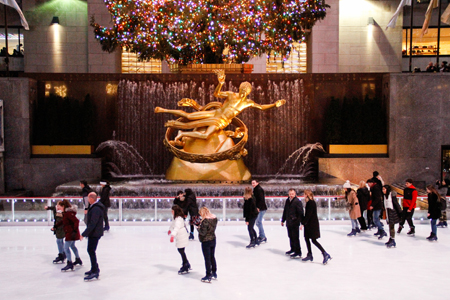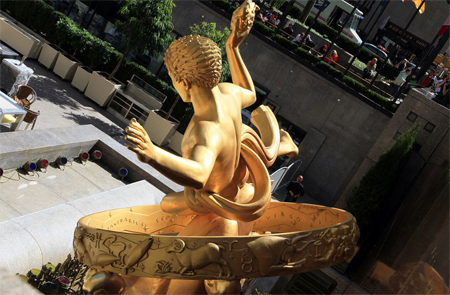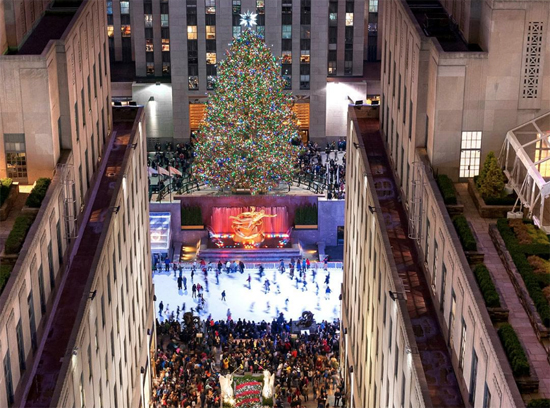Rockefeller Center Basks in Bronze During the Holiday Season
One of the most recognizable statues in New York City--also one of the most photographed--gets its time to shine in the spotlight this time of year as over one million visitors flock to Rockefeller Center to take in a glimpse of the Christmas tree and the festive action going on in the lower level at the ice skating rink.
 Rockefeller Center's Skating Rink, with Promethius on display.
Rockefeller Center's Skating Rink, with Promethius on display. Photograph courtesy of Courtney H. Diener-Stokes.
It’s hard to miss the 8-ton gilded, cast bronze sculpture Paul Manship created in 1934 called Prometheus. Located in the Center’s lower level, it stands 18 feet tall. The size pales in comparison to the height of the Christmas tree erected every December, located just above the sculpture on street level, but that doesn’t keep it from serving as a stunning backdrop for ice skaters, as it appears basking in all of its bronze glory.
Designed in the 1920s as a modern “city within a city, this New York landmark began with John D. Rockefeller Jr.'s unwavering vision for a cultural center more than 80 years ago. Rockefeller Center consists of 19 commercial buildings covering 22 acres between 48th and 51st Streets, facing Fifth Avenue. Today, nearly half a million tourists visit Rockefeller Center every day to view the great works of art and examples of stunning architecture throughout.
Born in 1885, the day before Christmas in St. Paul, Minnesota as the youngest of seven children, Manship headed to New York City in 1905 after enrolling in the Art Students League. Later, a three-year scholarship took him to Rome.
“He fell under the spell of Greek antiquity and the beauty of classicism,” the Smithsonian American Art Museum states on their website.
 Closeup of Promethius.
Closeup of Promethius. Photograph courtesy of Wikipedia.
The Greek Titan depicted in Manship’s work at Rockefeller Center had a reputation for being a clever trickster.
“The statue depicts the Greek Titan Prometheus, best known for going against the wishes of the gods and providing fire to humanity,” the Rockefeller Center guides tell tourists visiting every year.
Prometheus was given credit for civilization and progress.
“Over time, the classical figure came to represent human striving and the quest for knowledge,” they state.
While the Prometheus fountain is one of Manship’s most famous and recognizable works, his fascination with Greek Mythology is evident in many more of his statues. Housed in the collection of the Smithsonian American Art Museum, Manship’s works such as Atlanta and Day serve as more examples.
At the Cape Ann Museum in Gloucester, Massachusetts, Prometheus is the piece that serves as a point of reference for visitors to the museum that has some of his works in their permanent collection. One of the talking points of their tours when discussing Manship is his Prometheus sculpture because it is one of his most famous and easily recognizable works.
“That is the piece that is most often referenced,” says Martha Oaks, the museum’s curator. “It does set Manship in place for them.”
Oaks says the while Manship is known worldwide, his connection to Cape Ann isn’t always known.
“He was a permanent summer resident here from the 1940s on,” Oaks says. “He was friends with all of the major sculptors who made their way to this area — Walker Hancock, Katherine Layne Weems, George Demetrios, Anna Hyatt Huntington.”
She discusses Manhip’s connection and significance to the area.
 Rockefeller Center consists of 19 commercial buildings covering 22 acres between 48th and 51st
Rockefeller Center consists of 19 commercial buildings covering 22 acres between 48th and 51st Streets, facing Fifth Avenue.
Photograph courtesy of Rockefeller Center.
“He is one of the major figures in the history of Cape Ann,” she says.
A barn served as Manship’s summer studio.
“He purchased a property here and had a barn disassembled and moved to the property,” she says, adding the barn still stands today and the property is now the home of the Manship Artists Residency + Studios.
The Cape Ann Museum has a small number of his works in their permanent collection.
“One is a tortoise that was cast in 1998 and modeled in 1916,” she says. “We also have a bronze version of Indian Hunter and His Dog modeled in 1926 and we have a posthumous cast that was done in the 80s. We also have a bronze stork piece that he did.”
He was known for his animal studies as well as Greek Mythology being major influences in his work.
“What he studied and was exposed to in Greece was a strong influence in his work from then on,” she says.
Tourists come from all over the world to view Prometheus in all of it’s bronze glory, but especially during the holidays, when the area can have nearly 800,000 visitors a day. The Rockefeller Center plaza is open 365 days a year, and tours are available for those looking to get a closer look.
Resources:
Also in this Issue:
- Rockefeller Center Basks in Bronze During the Holiday Season
- Collaborating with Copper through Nature
- New Exhibit at The Jewish Museum Showcases More than 80 Rare Hannukah Lamps
- Trumpets, Weird and Wonderful Showcases the Art of Brass Instruments
- Armenian Museum of America Opens New Gallery
